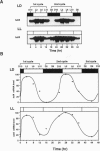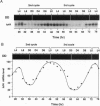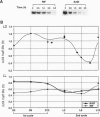Abstract
Levels of mRNA for the chloroplast-encoded elongation factor Tu (tufA) showed a dramatic daily oscillation in the green alga Chlamydomonas reinhardtii, peaking once each day in the early light period. The oscillation of tufA mRNA levels continued in cells shifted to continuous light or continuous dark for at least 2-3 days. Run-off transcription analyses showed that the rate of tufA transcription also peaked early in the light period and, moreover, that this transcriptional oscillation continued in cells shifted to continuous conditions. The half-life of tufA mRNA was estimated at different times and found to vary considerably during a light-dark cycle but not in cells shifted to continuous light. Light-dark patterns of transcription of several other chloroplast-encoded genes were examined and also found to persist in cells shifted to continuous light or dark. These results indicate that a circadian clock controls the transcription of tufA and other chloroplast-encoded genes.
Full text
PDF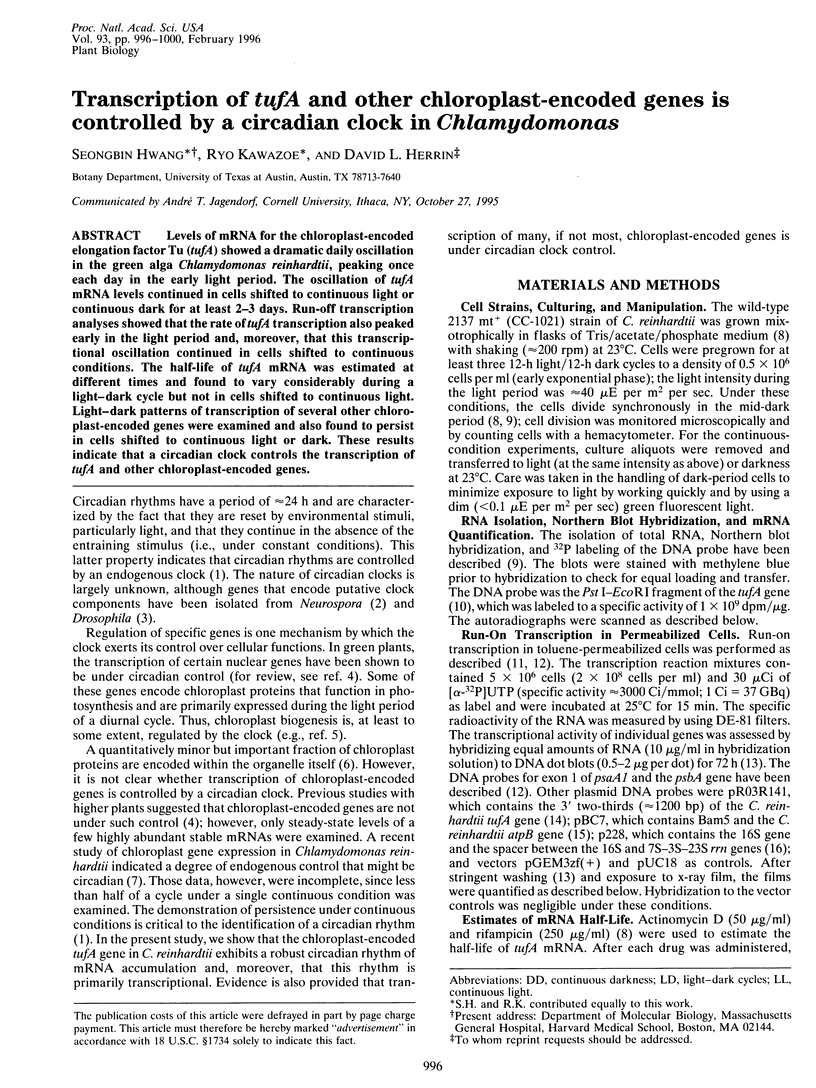
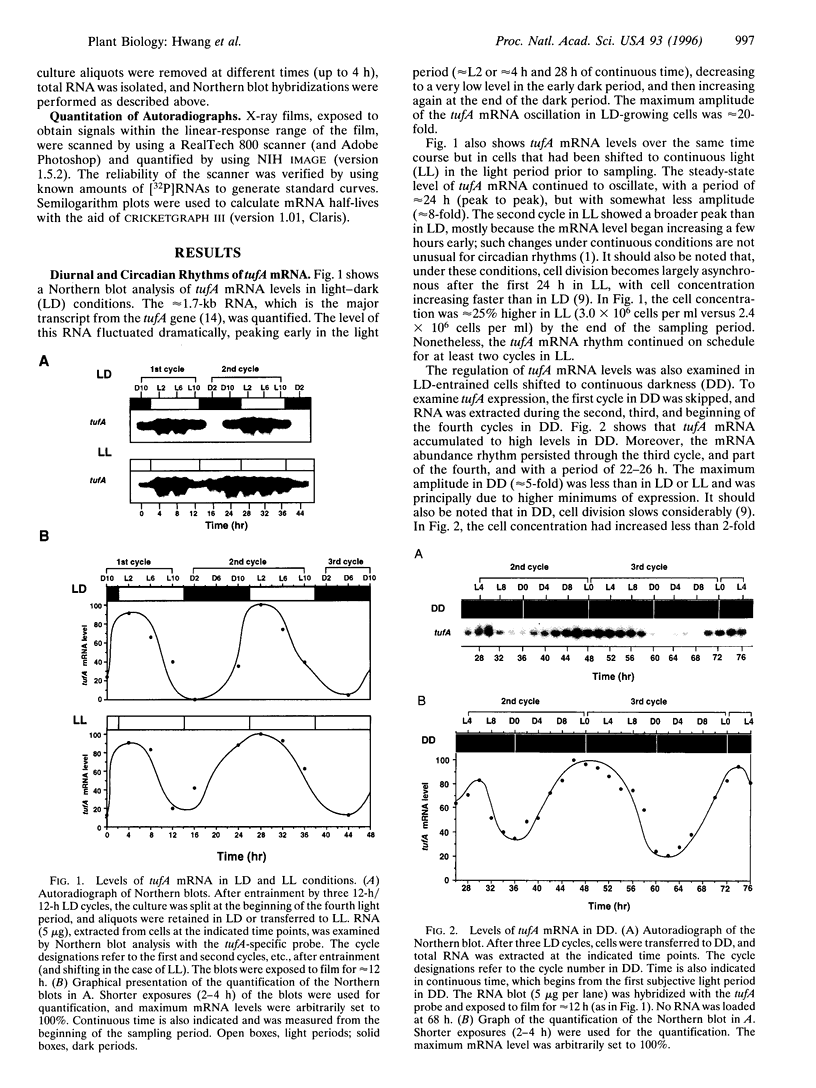
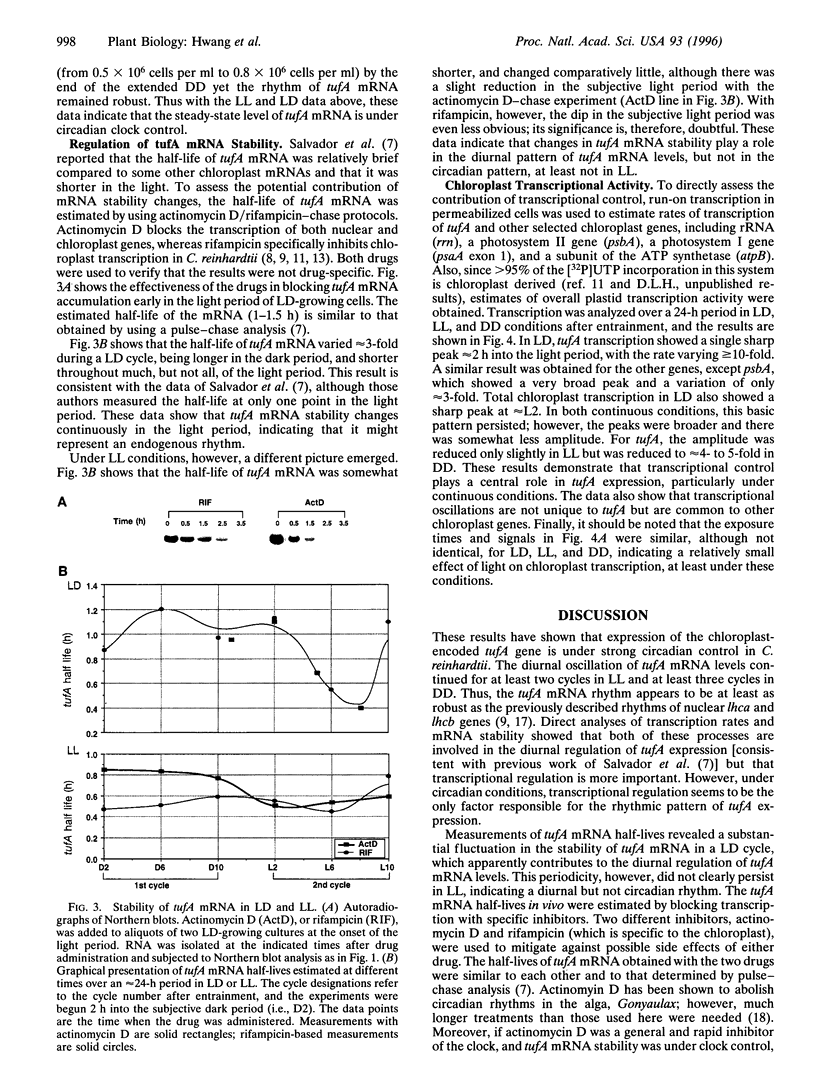
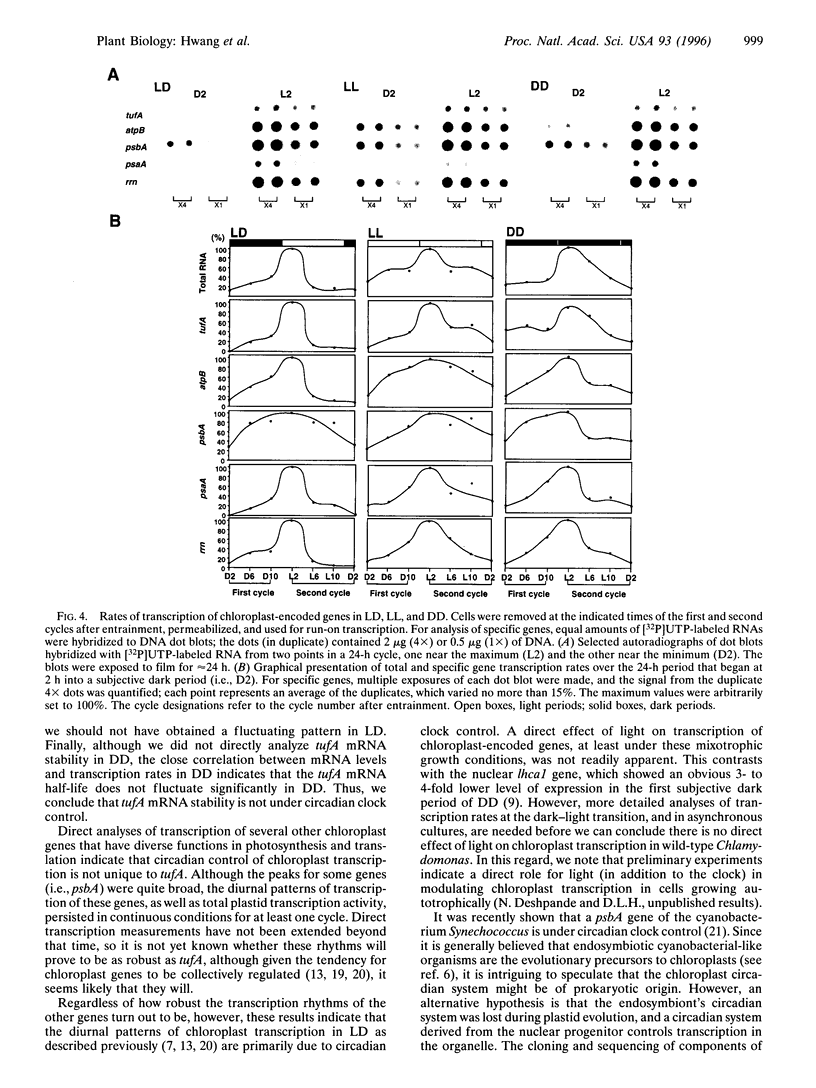
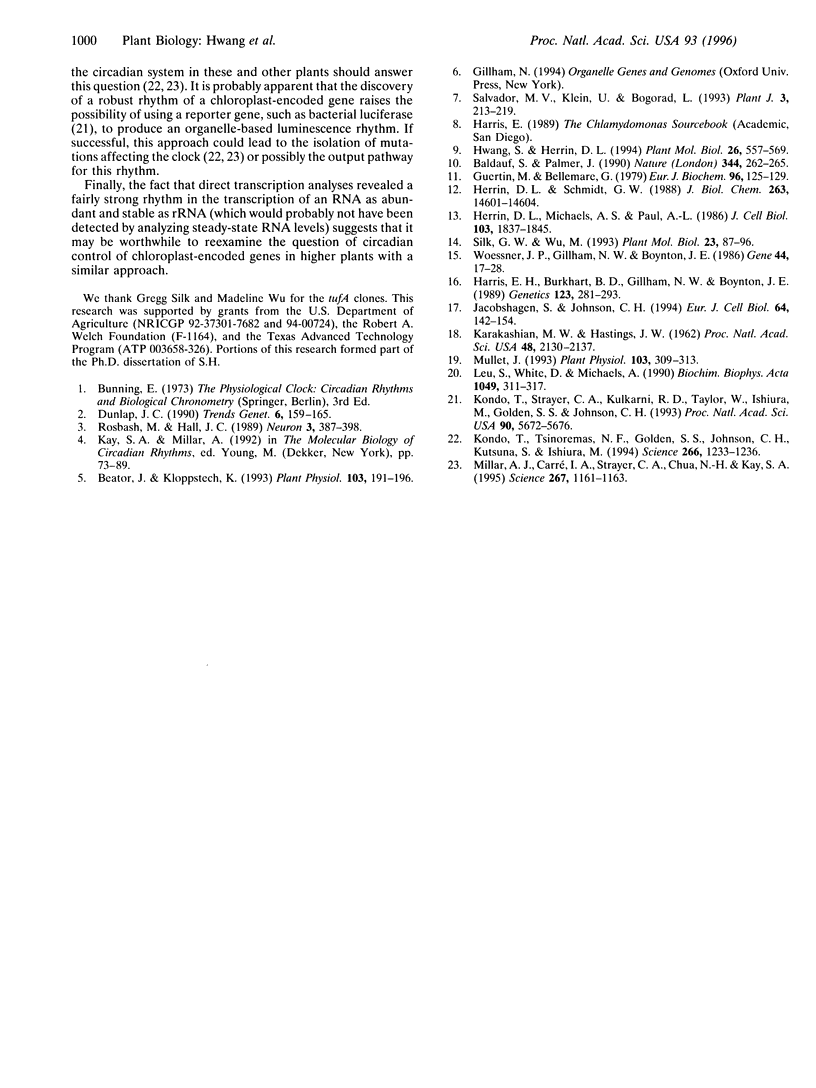
Images in this article
Selected References
These references are in PubMed. This may not be the complete list of references from this article.
- Baldauf S. L., Palmer J. D. Evolutionary transfer of the chloroplast tufA gene to the nucleus. Nature. 1990 Mar 15;344(6263):262–265. doi: 10.1038/344262a0. [DOI] [PubMed] [Google Scholar]
- Beator J., Kloppstech K. The Circadian Oscillator Coordinates the Synthesis of Apoproteins and Their Pigments during Chloroplast Development. Plant Physiol. 1993 Sep;103(1):191–196. doi: 10.1104/pp.103.1.191. [DOI] [PMC free article] [PubMed] [Google Scholar]
- Dunlap J. C. Closely watched clocks: molecular analysis of circadian rhythms in Neurospora and Drosophila. Trends Genet. 1990 May;6(5):159–165. doi: 10.1016/0168-9525(90)90151-u. [DOI] [PubMed] [Google Scholar]
- Guertin M., Bellemare G. Synthesis of chloroplast ribonucleic acid in Chlamydomonas reinhardtii toluene-treated cells. Eur J Biochem. 1979 May 2;96(1):125–129. doi: 10.1111/j.1432-1033.1979.tb13021.x. [DOI] [PubMed] [Google Scholar]
- Harris E. H., Burkhart B. D., Gillham N. W., Boynton J. E. Antibiotic resistance mutations in the chloroplast 16S and 23S rRNA genes of Chlamydomonas reinhardtii: correlation of genetic and physical maps of the chloroplast genome. Genetics. 1989 Oct;123(2):281–292. doi: 10.1093/genetics/123.2.281. [DOI] [PMC free article] [PubMed] [Google Scholar]
- Herrin D. L., Michaels A. S., Paul A. L. Regulation of genes encoding the large subunit of ribulose-1,5-bisphosphate carboxylase and the photosystem II polypeptides D-1 and D-2 during the cell cycle of Chlamydomonas reinhardtii. J Cell Biol. 1986 Nov;103(5):1837–1845. doi: 10.1083/jcb.103.5.1837. [DOI] [PMC free article] [PubMed] [Google Scholar]
- Herrin D. L., Schmidt G. W. trans-splicing of transcripts for the chloroplast psaA1 gene. In vivo requirement for nuclear gene products. J Biol Chem. 1988 Oct 15;263(29):14601–14604. [PubMed] [Google Scholar]
- Hwang S., Herrin D. L. Control of lhc gene transcription by the circadian clock in Chlamydomonas reinhardtii. Plant Mol Biol. 1994 Oct;26(2):557–569. doi: 10.1007/BF00013743. [DOI] [PubMed] [Google Scholar]
- Jacobshagen S., Johnson C. H. Circadian rhythms of gene expression in Chlamydomonas reinhardtii: circadian cycling of mRNA abundances of cab II, and possibly of beta-tubulin and cytochrome c. Eur J Cell Biol. 1994 Jun;64(1):142–152. [PubMed] [Google Scholar]
- KARAKASHIAN M. W., HASTINGS J. W. The inhibition of a biological clock by actinomycin D. Proc Natl Acad Sci U S A. 1962 Dec 15;48:2130–2137. doi: 10.1073/pnas.48.12.2130. [DOI] [PMC free article] [PubMed] [Google Scholar]
- Kondo T., Strayer C. A., Kulkarni R. D., Taylor W., Ishiura M., Golden S. S., Johnson C. H. Circadian rhythms in prokaryotes: luciferase as a reporter of circadian gene expression in cyanobacteria. Proc Natl Acad Sci U S A. 1993 Jun 15;90(12):5672–5676. doi: 10.1073/pnas.90.12.5672. [DOI] [PMC free article] [PubMed] [Google Scholar]
- Kondo T., Tsinoremas N. F., Golden S. S., Johnson C. H., Kutsuna S., Ishiura M. Circadian clock mutants of cyanobacteria. Science. 1994 Nov 18;266(5188):1233–1236. doi: 10.1126/science.7973706. [DOI] [PubMed] [Google Scholar]
- Leu S., White D., Michaels A. Cell cycle-dependent transcriptional and post-transcriptional regulation of chloroplast gene expression in Chlamydomonas reinhardtii. Biochim Biophys Acta. 1990 Jul 30;1049(3):311–317. doi: 10.1016/0167-4781(90)90103-9. [DOI] [PubMed] [Google Scholar]
- Millar A. J., Carré I. A., Strayer C. A., Chua N. H., Kay S. A. Circadian clock mutants in Arabidopsis identified by luciferase imaging. Science. 1995 Feb 24;267(5201):1161–1163. doi: 10.1126/science.7855595. [DOI] [PubMed] [Google Scholar]
- Mullet J. E. Dynamic regulation of chloroplast transcription. Plant Physiol. 1993 Oct;103(2):309–313. doi: 10.1104/pp.103.2.309. [DOI] [PMC free article] [PubMed] [Google Scholar]
- Rosbash M., Hall J. C. The molecular biology of circadian rhythms. Neuron. 1989 Oct;3(4):387–398. doi: 10.1016/0896-6273(89)90199-2. [DOI] [PubMed] [Google Scholar]
- Salvador M. L., Klein U., Bogorad L. Light-regulated and endogenous fluctuations of chloroplast transcript levels in Chlamydomonas. Regulation by transcription and RNA degradation. Plant J. 1993 Feb;3(2):213–219. doi: 10.1046/j.1365-313x.1993.t01-13-00999.x. [DOI] [PubMed] [Google Scholar]
- Silk G. W., Wu M. Posttranscriptional accumulation of chloroplast tufA (elongation factor gene) mRNA during chloroplast development in Chlamydomonas reinhardtii. Plant Mol Biol. 1993 Oct;23(1):87–96. doi: 10.1007/BF00021422. [DOI] [PubMed] [Google Scholar]
- Woessner J. P., Gillham N. W., Boynton J. E. The sequence of the chloroplast atpB gene and its flanking regions in Chlamydomonas reinhardtii. Gene. 1986;44(1):17–28. doi: 10.1016/0378-1119(86)90038-7. [DOI] [PubMed] [Google Scholar]



